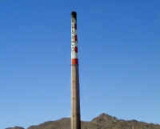Striking a Balance: The lead issue in Omaha
March 3, 2005
This is the story of how one mayor and one city, Omaha, dealt with the contamination from an ASARCO plant.
Written by Senator Eliot Shapleigh,

Big environmental issues require bold leadership that can strike a balance among competing interests. Let me explain. The area near downtown Omaha, Nebraska was once badly contaminated. The contamination came from old refineries and smelters that had been good corporate citizens in another era but had left serious environmental problems for the citizens of Omaha. But Mayor Hal Daub, who had been a four-term congressman, saw the 800 acres of brown field as an opportunity.
All the refineries and smelters had closed by 1995 except for an old smelter by the name of ASARCO. However, newly elected Mayor Hal Daub set out to close the remaining lead smelter and find a way to clean the land for adaptive reuse.
"We were sort of losing our young people and kind of dying on the vine. We had a big black hole between the airport and downtown." The goal was to build a convention center and get back to the river. Mayor Daub wanted to build a space along the Missouri river comparable to the Riverwalk in San Antonio for the people in Omaha to enjoy.
The mayor went to ASARCO and told them to shut down or risk a lawsuit. He promised to repermit them at a different location as long as their new smelter met modern environmental standards. But Mayor Daub was clear: they needed to close their smelter in Omaha and pay the cost of cleaning up the 800 acres.
A tremendous amount of negotiation was required to balance out all the different interests that were tied to ASARCO. There were the unions and the workers who did not want to see the jobs move somewhere else. Business leaders were also cautious at first because they were concerned with the impact of closing a long-standing corporate neighbor. Mayor Daub understood this and so he struck a delicate balance among all the stake holders to create new job opportunities.
"It took a long time to do it, but we tore everything out. We excavated, and we put in three non-permeable caps and put filling in between each cap and all that was done not only with our state environmental department, but every single piece of our reengineering was approved by the EPA."
"ASARCO wasn't happy with me the first three months after being mayor, but I was determined." Mayor Daub came to them with a plan. He had a plan for remediation and for adaptive reuse. There was a positive purpose behind Mayor Daub's vision for the 800 acre brown field. "It was about what the city and the riverfront would look like, and how clean and pleasant and how much more safe it would be, and how much more value all the neighborhoods would have."
The final result was that ASARCO closed their plant and paid $50 million dollars to clean up the land they had contaminated. The citizens of Omaha voted to have the Qwest Convention Center built and with it came exciting new development. Hotels, restaurants, and shops were built around the convention center. This once contaminated land along the Missouri river has brought new tourism and new life to Omaha.
Mayor Daub's Biographical Information:
Hal Daub was a U.S. Congressman from Nebraska currently serving as the chairman of the permanent statutory federal Social Security Advisory Board. He was also elected to two terms as the mayor of the City of Omaha. He is widely renowned for his exceptional leadership in restructuring the city into one of the foremost cultural, social, and economic centers of the Midwest.
Mayor Daub says that his career has been guided by his affinity for social and health policy and public service. In his professional life he has been able to concentrate on growing and managing small and large businesses. He is also served as an elected Advisory Board Member of the National League of Cities. His extensive public service allowed him to accomplish great achievements for the State of Nebraska and for Omaha.
![]()
![]()
Related Stories